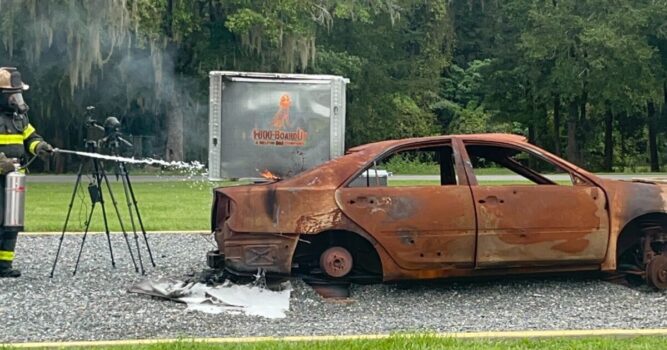Batteries are an inescapable part of modern life. They power everything from cellphones, cars, and all kinds of everyday items. But their tendency to cause problems is undeniable.
“Sometimes I wish they didn’t exist,” said Jimmy Patronis, Florida chief financial officer and State Fire Marshal.
Firefighters, law enforcement, and other emergency service personnel gathered at the opening day of the second Annual Lithium-Ion Battery Safety Symposium Thursday at the Florida State Fire College in Ocala.
The two-day event, which had 240 people register, aims to educate first responders and the general public on how to prevent, prepare, and manage lithium-ion battery incidents.
In the state of Florida, the most common lithium-ion fire incidents involve scooters and hoverboards. Three of these fires occurred in different parts of the state in 2023, and 19 scooter or hoverboard fires have been reported so far in 2024, according to the Florida Fire and Incident Reporting System.
CFO and State Fire Marshal Jimmy Patronis speaks at the 2nd Annual Lithium-Ion Battery Safety Symposium on Sept. 12, 2024, at the Florida State Fire College in Ocala. Patronis emphasized the growing challenges of managing battery-related fires and the need for improved safety measures. (Austin Caruso/WUFT News)
As these batteries become more prevalent, more issues with them are likely to occur. One of the biggest issues Florida fire departments face are electric vehicle (EV) fires and how to best resolve the problem.
“Strategy is the single most important thing that affects the safety of everyone there,” said Gary Sharp, a retired deputy fire chief and the current vice president of training at Safeware Inc., a protective safety equipment and emergency preparedness supplies company.
Lithium-ion battery fires cannot be extinguished with water. Firefighters must either use a foam substance or let the fire burn out on its own. Lithium-ion battery fires are normally exceedingly difficult to put out.
When firefighters are figuring out what strategy they should take at the scene, they must first figure out if the battery is on fire. A few signs that the battery is on fire may be a bubble gum smell, white smoke coming from the bottom of the car, and a sound like a jet engine coming from the vehicle.
Firefighters can then take one of three strategies, the first being offensive which occurs in the hot zone. In the hot zone, firefighters risk injury or death when they are up close attempting to assess, vent, or extinguish the fire.
The second strategy is defensive which occurs in the warm zone and still can lead to firefighter injury. This is when firefighters are trying to extinguish a fire from afar. The distance may depend very much on the size of the vehicle or fire.
The final strategy is nonintervention. This is when the firefighters decide to let the fire burn out on its own.
“The one thing that I can say about these fires is that they are consistently inconsistent,” said Battalion Chief Robert Rezende with the San Diego Fire-Rescue Dept.
The firefighter statue stands prominently in front of the auditorium at the Florida State Fire College in Ocala on Sept. 12, 2024. The statue is surrounded by symbolic flames and flags. (Austin Caruso/WUFT News)
Lithium-ion battery fires are not only started by EVs. These fires can also be started by unattended or overcharged phones, power tools, or scooters short-circuiting.
The Division of State Fire Marshal recommends supervising devices while they charge and disconnecting them from a charger once they are done because a battery fire can happen to anyone.
“I’ve responded to a call at a firefighter’s house in his shed,” said Marion County firefighter Parker Whitmore.
The only thing that is more difficult than putting these fires out is disposing of the damaged or destroyed battery afterward.
Used batteries must be stored in a metal non-combustible container that is filled with a recycled glass mixture. This mixture absorbs heat and does not allow electricity to transfer.
The firefighters then seal and ship the container. A container the size of a five-gallon bucket can cost up to $200. Lithium-ion battery fires can occur within seconds, minutes, hours, weeks, or even months after the battery has been removed, according to Sharp.
It is a new world of problems for fire departments everywhere and the Division of State Fire Marshal is doing its best to ensure that everyone is educated and prepared.
“Every form of travel is piling into some form of electricity from planes, trains, to automobiles,” said Sharp.









